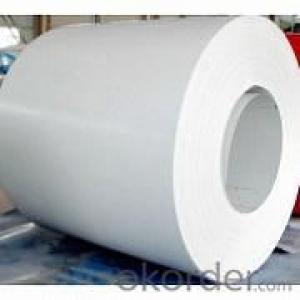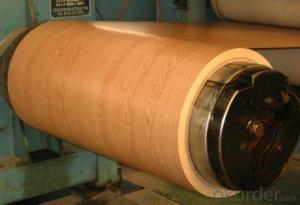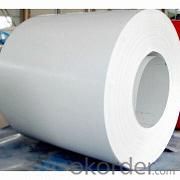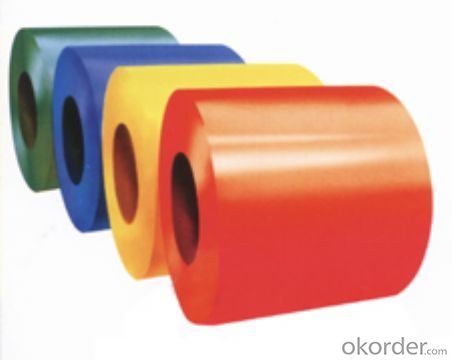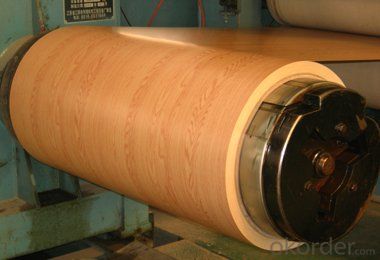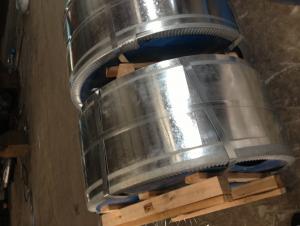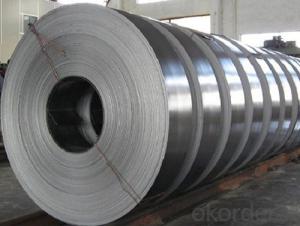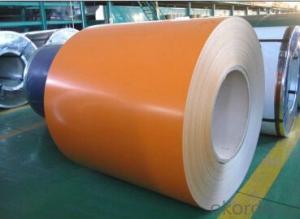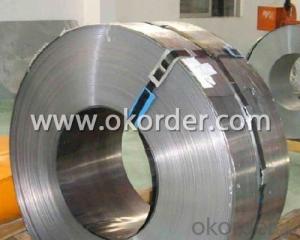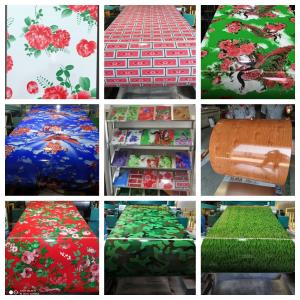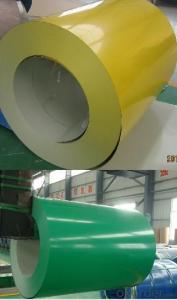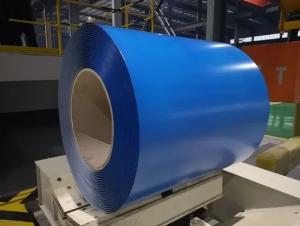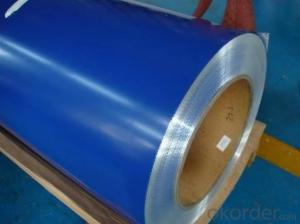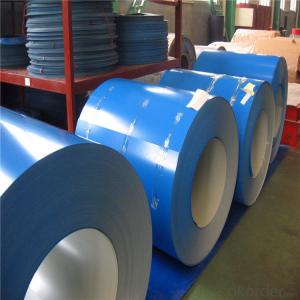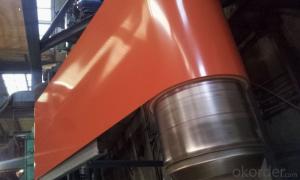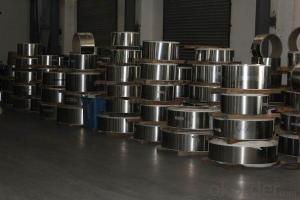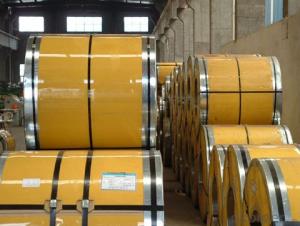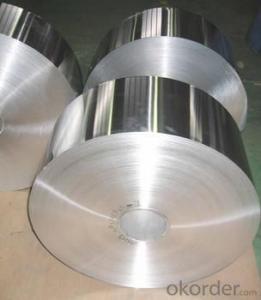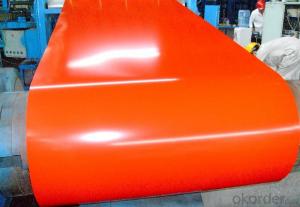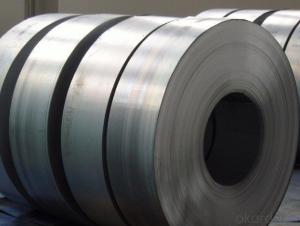Color coated steel coils PPGI PPGL
- Loading Port:
- Shanghai
- Payment Terms:
- TT OR LC
- Min Order Qty:
- 50 m.t.
- Supply Capability:
- 100000 m.t./month
OKorder Service Pledge
OKorder Financial Service
You Might Also Like
colour coated steel
painting colour steel , zinc coated steel , lead coated steel
Standard: | AISI,ASTM,BS,DIN,GB,JIS | Grade: | DX51D,SGCC,SPCC,CGCC | Thickness: | 0.17-1.5mm |
Place of Origin: | Taian China (Mainland) | Brand Name: | HengJi | Model Number: | HJ |
Type: | Steel Coil | Technique: | Cold Rolled | Surface Treatment: | RAL color cremated, oiled, skin passed |
Application: |
building metal roofing components,house appliance | Width: | 914-1250mm | Length: | customized |
price: | favorable price | Our Customers | Steel force, Stemcor, Duferco, Samsung , G&G,Hyosung,CNBM |
Packaging & Delivery
Packaging Detail: | standard export packing or customized |
Delivery Detail: | 15 days after prepayment |
Specifications:
galvanized steel coil:
1.Thickness:0.17mm-1.5mm
2.Zinc coated:40g-275g/2
3.Standard:dx51d+z,sgcc
We manufacture Galvanized Steel Coils,Pre-painted Galvanized Steel Coils , etc
Prepainted steel coil features:
1. Zinc coating :40-120g(as reauired)
2. thickness:0.17-1.2mm
3. width:914-1250mm(900mm,1215mm,1250mm,1000mm the most common)
4. coil id:508m610mm
5. coil weight: 3-12(as required)
6. surface treatment:RAL color
Galvanized steel coil features:
1. Zinc coating :40-275g( as required)
2. thickness:0.17-1.2mm
3. width:914-1250mm(900mm,1215mm,1250mm,1000mm the most common)
4. coil id:508m610mm
5. coil weight: 3-12(as required)
6. surface treatment: cremated, oiled, skin passed
7. Spangle: regular,small, zero
8.Application: With excellent cold bending molded manufacturablity, good decoration effect, strong anti-corrosion ability, galvanized steel coils and sheets are also pollution-free and easily recycled. Accordingly, they can be used as final products and basic plates of color coated steel coils and widely applied in construction, home appliances, decoration, ect.
Product name | steel coil,galvanized steel,galvanized steel coil |
Material | DX51D, SGCC, SPCC, CGCC, DX51D |
Normal thickness | 0.17-1.2mm |
Normal width | 900mm,914mm, 1000mm, 1200mm, 1220mm, 1250mm |
Coil weight | 3-12ns |
Certificate | BV & SGS |
Original | Shandong,China |
Payment terms | L/C or T/T |
Delivery time | within 15 ~ 25 days after 30% prepayment |
- Q: What are the different tempering processes for steel strips?
- There are several different tempering processes for steel strips, including conventional tempering, martempering, austempering, and intercritical tempering. Conventional tempering involves heating the steel strip to a specific temperature and then allowing it to cool slowly, which helps to reduce brittleness and improve toughness. Martempering involves rapidly quenching the steel strip in a salt bath or oil to achieve a tempered martensite structure, providing a balance between strength and toughness. Austempering is a process where the steel strip is quenched in a salt bath or oil at a specific temperature and then held at that temperature until it reaches a desired structure, resulting in improved ductility and toughness. Intercritical tempering involves heating the steel strip to a temperature between the critical points of austenite and ferrite and then cooling it in a controlled manner, which helps to achieve a combination of strength and ductility.
- Q: What are the main applications of steel strips?
- Steel strips possess exceptional properties and versatility, enabling their wide-ranging applications in diverse industries. Notably, steel strips find extensive use in various sectors, as outlined below: 1. Automotive Industry: Within the automotive sector, steel strips play a pivotal role in the production of multiple components such as springs, suspension systems, brackets, reinforcements, and body panels. The inherent strength, durability, and formability of steel strips render them an ideal choice for enhancing the structural integrity and safety of vehicles. 2. Construction Industry: The construction industry relies heavily on steel strips for numerous purposes. These strips are commonly employed in fabricating structural elements like beams, columns, and trusses. Additionally, they are utilized in manufacturing roofing, cladding, and fencing materials. Steel strips ensure the strength, stability, and longevity of structures, thus being an indispensable material in construction projects. 3. Electrical Industry: Steel strips find extensive use in the electrical industry, specifically in the production of electrical transformers and motors. Owing to their magnetic properties, steel strips are optimal for creating efficient and reliable electromagnetic circuits, facilitating the transmission and transformation of electrical energy. 4. Packaging Industry: Steel strips play a crucial role in the packaging industry, being employed for manufacturing metal packaging materials such as cans, drums, and containers. The durability, corrosion resistance, and ease of forming of steel strips make them suitable for safeguarding and preserving a wide array of goods, including food and beverages, chemicals, and other perishable or sensitive products. 5. Manufacturing Industry: The manufacturing industry extensively employs steel strips in various production processes like stamping, forming, and fabrication. These strips are commonly utilized in the manufacturing of appliances, furniture, machinery, and equipment, owing to their high strength, ductility, and ability to be shaped into complex geometries. 6. Aerospace Industry: In the aerospace industry, steel strips find application in the manufacturing of aircraft components and structures. Their exceptional strength-to-weight ratio, corrosion resistance, and heat resistance make them an optimal choice for high-performance materials essential in applications such as aircraft frames, landing gears, and engine components. Overall, steel strips exhibit their utility across multiple industries, including automotive, construction, electrical, packaging, manufacturing, and aerospace. The unique combination of strength, durability, formability, and magnetic properties renders steel strips an indispensable material, contributing to the advancement and progress of modern technology and infrastructure.
- Q: How are steel strips used in the production of elevator components?
- Steel strips are used in the production of elevator components to provide strength, durability, and structural integrity. These strips are often used to create the framework, support brackets, and other essential parts of the elevator system. They are also used in the fabrication of doors, walls, and floors, ensuring the overall safety and stability of the elevator structure.
- Q: How are steel strips used in the production of metal fences?
- Metal fences rely on steel strips as a vital ingredient in their manufacturing process. These strips are typically crafted from top-notch steel that possesses high durability and resistance against corrosion, making them well-suited for outdoor usage. Within the production process, steel strips serve to construct the skeleton or framework of the metal fence. They are trimmed to the necessary dimensions and molded into various sections, such as posts, rails, and pickets. This framework provides the fundamental strength and support required to withstand external forces, such as wind or impact. Furthermore, steel strips may also be employed to fortify the connection points of the fence. They can be either welded or bolted onto the framework to amplify stability and eliminate any potential weak spots. This reinforcement guarantees the fence's stability and security. Moreover, steel strips can also be utilized to amplify the visual appeal of the metal fence. They can be shaped into decorative patterns or designs, adding a visually pleasing component to the overall appearance of the fence. These strips may also be utilized as ornamental features on the top or between sections of the fence, further enhancing its aesthetics. In summary, steel strips occupy a vital role in the production of metal fences. They offer the necessary strength, durability, and support required to create a robust and long-lasting fence. Additionally, they contribute to the visual allure of the fence, making it an attractive choice for both residential and commercial applications.
- Q: How are steel strips used in electrical applications?
- Steel strips are commonly used in electrical applications as conductor materials for power transmission and distribution. They are utilized in the manufacturing of various electrical components such as transformers, inductors, and motor cores. Steel strips provide high electrical conductivity and magnetic properties, allowing for efficient energy transfer and electromagnetic field generation.
- Q: How do steel strips perform in terms of weldability?
- Good weldability is a characteristic commonly found in steel strips. The welding properties of steel strips can differ based on the composition and processing methods used. However, as a whole, steel strips are known for being easy to weld and capable of creating strong and long-lasting welds. The weldability of steel strips primarily stems from their low carbon content, which facilitates fusion during the welding process. Steel strips are often produced with specific alloying elements, such as manganese, silicon, and carbon equivalents, to enhance their weldability. These elements improve the strength, ductility, and toughness of the weld joint. In addition, steel strips possess favorable thermal conductivity, which ensures even heat distribution during welding and reduces the risk of distortion or cracking. Furthermore, their high melting point and good heat resistance enable them to withstand the intense temperatures generated during welding without compromising their structural integrity. Moreover, steel strips can be easily welded using different techniques, including arc welding (such as shielded metal arc welding or gas metal arc welding), resistance welding, and laser welding. They can also be successfully welded to other materials like stainless steel or aluminum through appropriate welding processes and compatible welding consumables. Nevertheless, it is important to note that the weldability of steel strips can be influenced by factors such as the specific steel grade, surface conditions, cleanliness, and welding parameters. Therefore, it is crucial to follow suitable welding procedures, including proper pre-weld and post-weld treatments, to ensure optimal weld quality and performance. In conclusion, steel strips are generally regarded as having good weldability, making them a popular choice in various industries that require dependable and efficient welding processes.
- Q: How are steel strips measured and classified?
- Steel strips undergo measurement and classification according to their dimensions, thickness, and mechanical properties. Typically, the measurement of steel strips encompasses three primary parameters: width, thickness, and length. Width refers to the distance between the strip's edges, while thickness signifies the gap between its top and bottom surfaces. Conversely, length pertains to the strip's overall size. Regarding thickness, steel strips are commonly classified into thin, medium, or thick categories. Thin strips possess a thickness of less than 3 mm, medium strips range from 3 mm to 10 mm, and thick strips exceed 10 mm in thickness. This classification holds significance as it determines the suitability of the steel strip for diverse applications, including the automotive, construction, and manufacturing industries. Furthermore, steel strips can also undergo classification based on their mechanical properties. These properties encompass tensile strength, yield strength, elongation, hardness, and other pertinent characteristics. These properties play a crucial role in determining the strength and durability of the steel strip, thereby rendering it suitable for specific applications. For instance, industries requiring robust materials commonly employ steel strips with high tensile strength, while those necessitating complex shaping or bending prefer strips with superior formability. Moreover, apart from dimensions and mechanical properties, steel strips may undergo classification based on their surface finish. This classification encompasses factors such as the presence of a protective coating or the level of smoothness. Surface finish impacts the appearance, corrosion resistance, and overall quality of the steel strip. Overall, the measurement and classification of steel strips necessitate consideration of dimensions, thickness, mechanical properties, and surface finish. Understanding these parameters proves essential in selecting the most appropriate steel strip for a specific application, ensuring optimal performance and durability.
- Q: How are steel strips used in the production of metal staircases?
- Steel strips are commonly used in the production of metal staircases as they offer several advantages. Firstly, steel strips provide structural support and stability to the staircase framework. They are often used as the main structural components, forming the stringers or supports that hold up the treads and risers. The high strength and rigidity of steel allow for the construction of sturdy and durable staircases that can withstand heavy loads and constant use. Additionally, steel strips are used to create the treads and risers themselves. The strips are often shaped and welded together to form solid and secure steps, ensuring a safe and comfortable walking surface. Steel is a preferred material for this purpose due to its resistance to wear and tear, as well as its ability to withstand various environmental conditions. Moreover, steel strips can be customized to fit the specific design requirements of the staircase. They can be cut, bent, and shaped into different sizes and profiles to create unique and aesthetically pleasing staircases. This versatility allows for the creation of various styles, including straight, spiral, and curved staircases. Lastly, steel strips can be finished with different coatings or treatments to enhance their appearance and protect them from corrosion. This ensures that the metal staircases maintain their visual appeal and functionality over time, even in demanding environments. In summary, steel strips play a crucial role in the production of metal staircases by providing structural support, forming the treads and risers, allowing for customization, and offering protection against corrosion. Their strength, durability, and versatility make them an ideal choice for constructing safe and visually appealing staircases.
- Q: How are steel strips coated with protective coatings?
- Steel strips can be coated with protective coatings through a process called steel coil coating. This process involves applying a layer of protective material onto the surface of the steel strip to enhance its durability and resistance to corrosion, abrasion, and other forms of damage. The coating process typically begins with the cleaning and preparation of the steel strip. This is done to ensure that the surface is free from any contaminants such as dirt, oil, or rust, which could affect the adhesion of the protective coating. The cleaning process may involve mechanical cleaning techniques, chemical treatments, or a combination of both. Once the steel strip is clean, it is then coated with the protective material. There are several methods for applying the coating, including roller coating, spray coating, or dip coating. Roller coating involves passing the steel strip through a set of rollers, which evenly apply the coating material onto the surface. Spray coating involves using a high-pressure spray gun to apply the coating in a controlled manner. Dip coating involves immersing the steel strip into a bath of the coating material, ensuring that the entire surface is covered. After the coating is applied, the steel strip is usually cured or dried to ensure that the coating adheres properly and forms a durable protective layer. This can be done through various methods such as oven curing, infrared heating, or air drying, depending on the specific coating material used. The choice of protective coating material depends on the intended application and the desired level of protection. Common types of protective coatings for steel strips include organic coatings such as paints, lacquers, or polymers, as well as inorganic coatings such as metallic coatings or ceramic coatings. Each type of coating offers different properties and advantages in terms of corrosion resistance, weatherability, scratch resistance, or chemical resistance. In conclusion, steel strips are coated with protective coatings through a process that involves cleaning and preparing the surface, applying the coating material using techniques such as roller coating, spray coating, or dip coating, and then curing or drying the coating to ensure its durability. The choice of coating material depends on the desired level of protection and the specific application.
- Q: What are the environmental benefits of using steel strips?
- There are several environmental benefits associated with using steel strips. Firstly, steel is a highly recyclable material, meaning that it can be repurposed and reused multiple times without losing its properties. This reduces the demand for raw materials and the energy required for manufacturing new steel products. Additionally, steel strips have a long lifespan and are resistant to corrosion, reducing the need for frequent replacements. This leads to less waste generation and lower carbon emissions associated with production and transportation. Lastly, steel is known for its strength and durability, making it an ideal choice for construction and infrastructure projects, which can contribute to more sustainable and resilient structures.
Send your message to us
Color coated steel coils PPGI PPGL
- Loading Port:
- Shanghai
- Payment Terms:
- TT OR LC
- Min Order Qty:
- 50 m.t.
- Supply Capability:
- 100000 m.t./month
OKorder Service Pledge
OKorder Financial Service
Similar products
Hot products
Hot Searches
Related keywords
